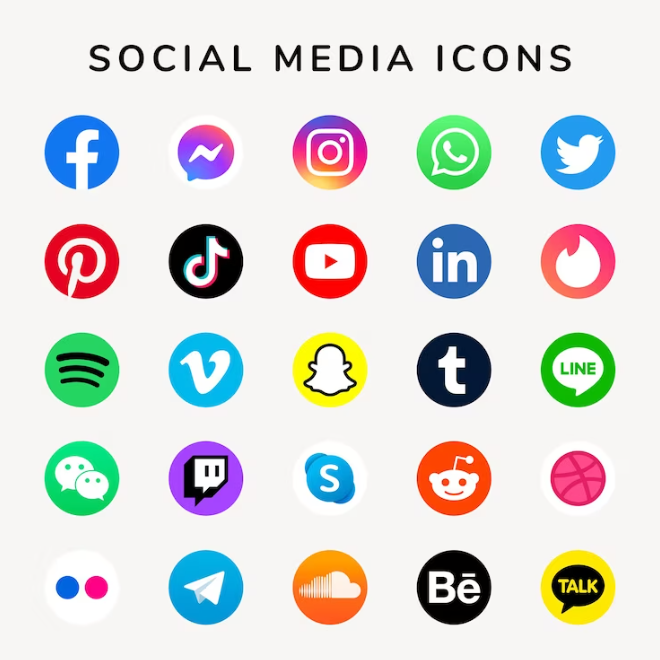Types of Social Media Platforms for Marketing Impacts
Social Media Platforms in today’s competitive digital world, have become the heartbeat of online communication. From Facebook to Instagram, Twitter to TikTok, these platforms are not just spaces for sharing cute cat videos or vacation photos; they are powerful tools that businesses use to connect with their audiences. Have you ever wondered why some marketing strategies on social media hit the bullseye while others miss the mark? Let’s dive into the science behind social media platforms and marketing success, demystifying the secrets that make these online spaces a goldmine for businesses.

Understanding Your Audience
One of the fundamental principles of successful social media marketing is understanding your audience. Imagine you’re throwing a party. You’d invite people who enjoy the same things you do. Social media platforms allow businesses to do just that. By analyzing user data, companies can identify their target audience’s interests, behaviours, and preferences. This insight helps create content that resonates with the audience, like a favourite tune at the party.
Engagement is Key
Have you ever noticed how a smile can light up a room? Similarly, engaging content brightens up social media platforms. It could be a funny meme, an informative infographic, or a heartwarming story. When people engage with content by liking, sharing, or commenting, it creates a ripple effect. Algorithms on these platforms recognize engagement as a sign of exciting content, making it more visible to others. Think of it as a virtual pat on the back that says, “Hey, this is worth checking out!”
Visual Appeal Matters
A picture is worth a thousand words, they say, and on social media platforms, this holds. Visually appealing content grabs attention in the midst of a sea of posts. High-quality images, vibrant videos, and eye-catching graphics stop the endless scroll and make users pause. It’s like an inviting storefront display that beckons you to enter a shop. Once inside, the engaging content takes the visitor on a journey, leaving a lasting impression.
Adaptation and Innovation
Social media platforms are like bustling markets where trends change in the blink of an eye. What worked yesterday might not work tomorrow. Successful marketers stay ahead by adapting and innovating. They keep an eye on emerging trends, experiment with new formats, and analyze data to understand what works best. It’s like being a chef who constantly tweaks the recipe to create the perfect dish – a blend of creativity and data-driven decision-making.
Consistency Builds Trust
Imagine if your favourite bakery only baked fresh bread sporadically. You wouldn’t know when to get your favourite loaf! Consistency is the secret ingredient that builds trust on social media. Regular posts, timely responses to comments, and a cohesive brand voice make your audience feel like they’re conversing with a friend, not just a faceless corporation. Trust, once earned, keeps people coming back for more.

Types of Social Media Platforms for Marketing
Each social media platform has versatile vibes and audience. Choosing the right one depends on your business and the people you want to reach. By understanding these platforms, businesses can create a robust online presence and connect with their customers in meaningful ways. Social media platforms come in different types, each serving a unique marketing purpose. Let’s explore a few of them in simple terms.
Facebook: Facebook is like an extensive online community where people of all ages hang out. It’s an excellent place for businesses to set up shop. People use Facebook to share pictures, videos, and exciting articles. For marketing, businesses can create unique pages. Imagine it like having a storefront on a busy street. You can put up your products, share news, and even host events. Also, businesses can advertise to specific groups of people, making it easier to reach potential customers.
Instagram: Instagram is like a photo album where you can share your best moments visually. It’s a favourite among younger people. Businesses can post eye-catching photos and short videos here. Imagine it as a gallery showcasing your products or services. Many businesses use Instagram to create a strong visual brand. You can also run ads and even sell products directly through the platform.
Twitter: Twitter is like a giant bulletin board where everyone posts short messages. These messages are called tweets. People use it to share thoughts, news, and interesting links. For businesses, Twitter is great for quick updates and engaging with customers. It’s like having a conversation with your audience. You can share promotions news and interact directly with your customers.
LinkedIn: LinkedIn is like a digital resume or a professional networking event. It’s the go-to place for professionals. People use LinkedIn to connect with colleagues, find jobs, and share industry news. For businesses, it’s a powerful tool for B2B (business-to-business) marketing. You can showcase your company, post job openings, and connect with other businesses in your industry.
YouTube: YouTube is like a TV channel where you can broadcast your videos to the world. It’s the second-largest search engine after Google. People go to YouTube to watch tutorials, reviews, and entertaining videos. For businesses, YouTube is fantastic for creating video content. You can make how-to guides, product demonstrations, or even entertaining ads. It’s a great way to show your products or services in action.

Choose the Right Social Media Platform
The best social media platform for marketing depends on your business goals and target audience. Different platforms offer unique benefits. Let’s break down a couple of popular ones in simple words:
Facebook: Facebook is like a big community gathering. It’s versatile and works well for most businesses. You can create an online business page where you share your products, services, and updates. Facebook’s advertising tools allow you to target specific groups, ensuring your messages reach the right people. It’s excellent for building a community around your brand and engaging with your audience through comments and messages.
Instagram: Instagram is like a visual showcase. Instagram is perfect if your business relies heavily on visuals (like fashion, food, or travel). You can post high-quality photos and short videos of your products. The platform has a younger audience, so this can be an excellent choice if your target market is more youthful. Instagram Stories and Reels are interactive features that can help you engage with your audience creatively.
LinkedIn: LinkedIn is like a professional networking event. It’s the go-to platform for B2B (business-to-business) marketing and businesses offering professional services. You can showcase your expertise, connect with other businesses, and even post articles demonstrating your knowledge. LinkedIn is excellent for building industry relationships and finding potential clients or partners.
YouTube: YouTube is like your own TV channel. YouTube is powerful if your business involves tutorials, product demonstrations, or any content that can be shown through video. It’s the world’s second-largest search engine, so people often come here to find answers. You can create videos that provide value to your audience, building trust and authority around your brand.
Ultimately, the best platform depends on your content and audience. It’s often a good idea to use a mix of platforms to reach a broader audience and engage with your customers differently.
In conclusion
the science behind social media platforms and marketing success boils down to understanding your audience, creating engaging and consistent content, ensuring visual appeal, and being adaptable. By mastering these elements, businesses can unlock the full potential of social media, turning casual scrollers into loyal customers, one post at a time. So, next time you scroll through your favourite social media platform, remember, there’s more than meets the eye – science, strategy, and a sprinkle of creativity shaping your online experience.
